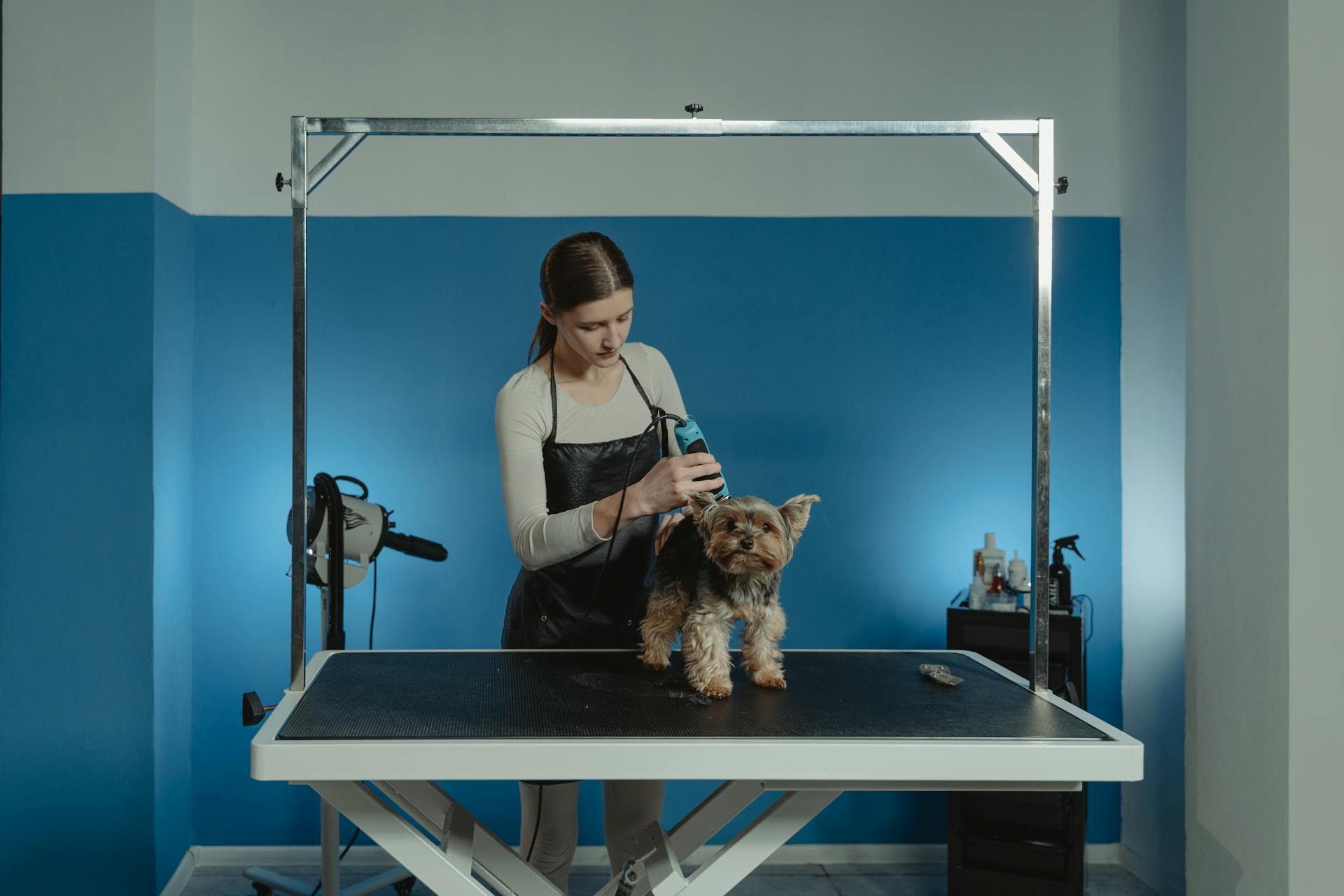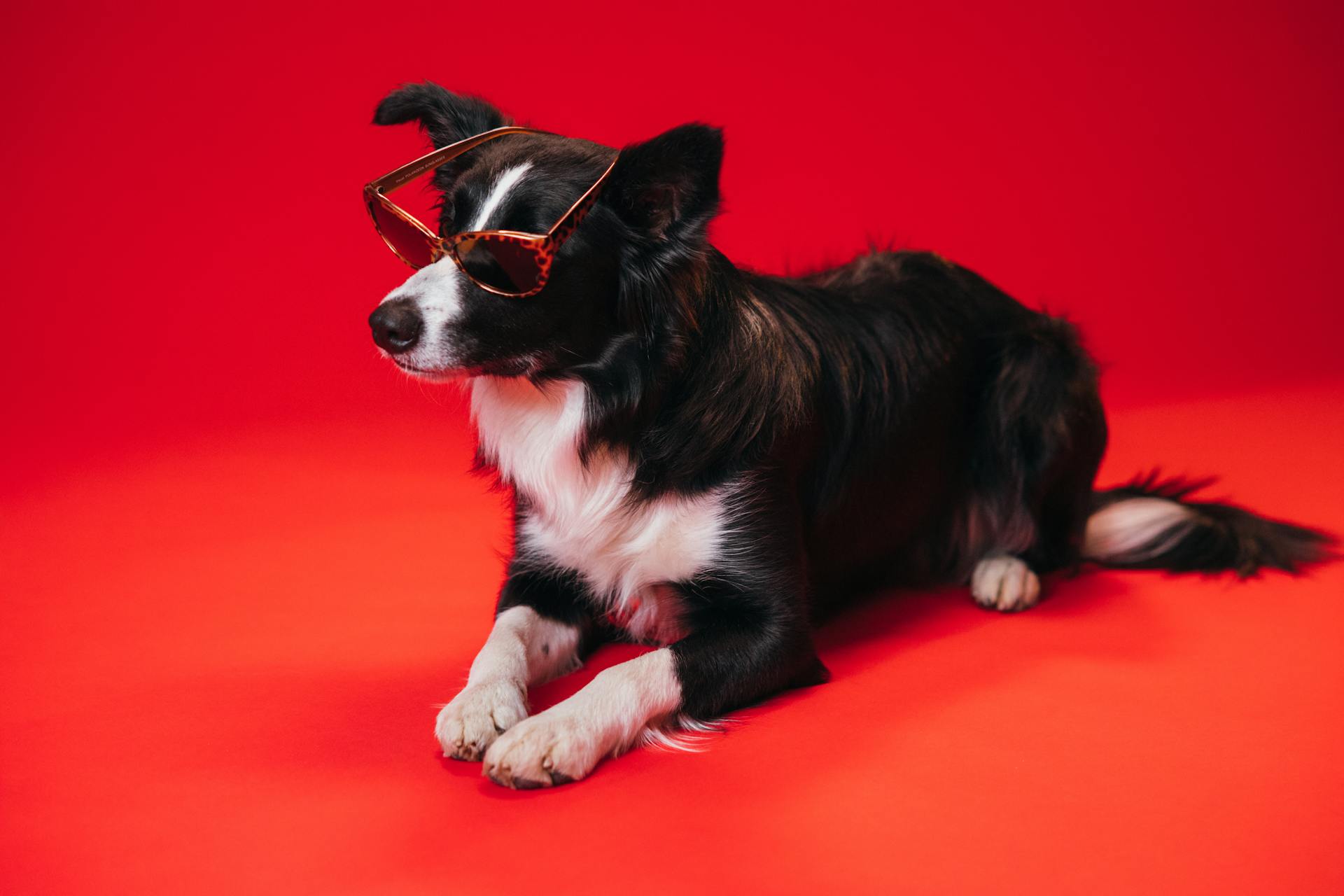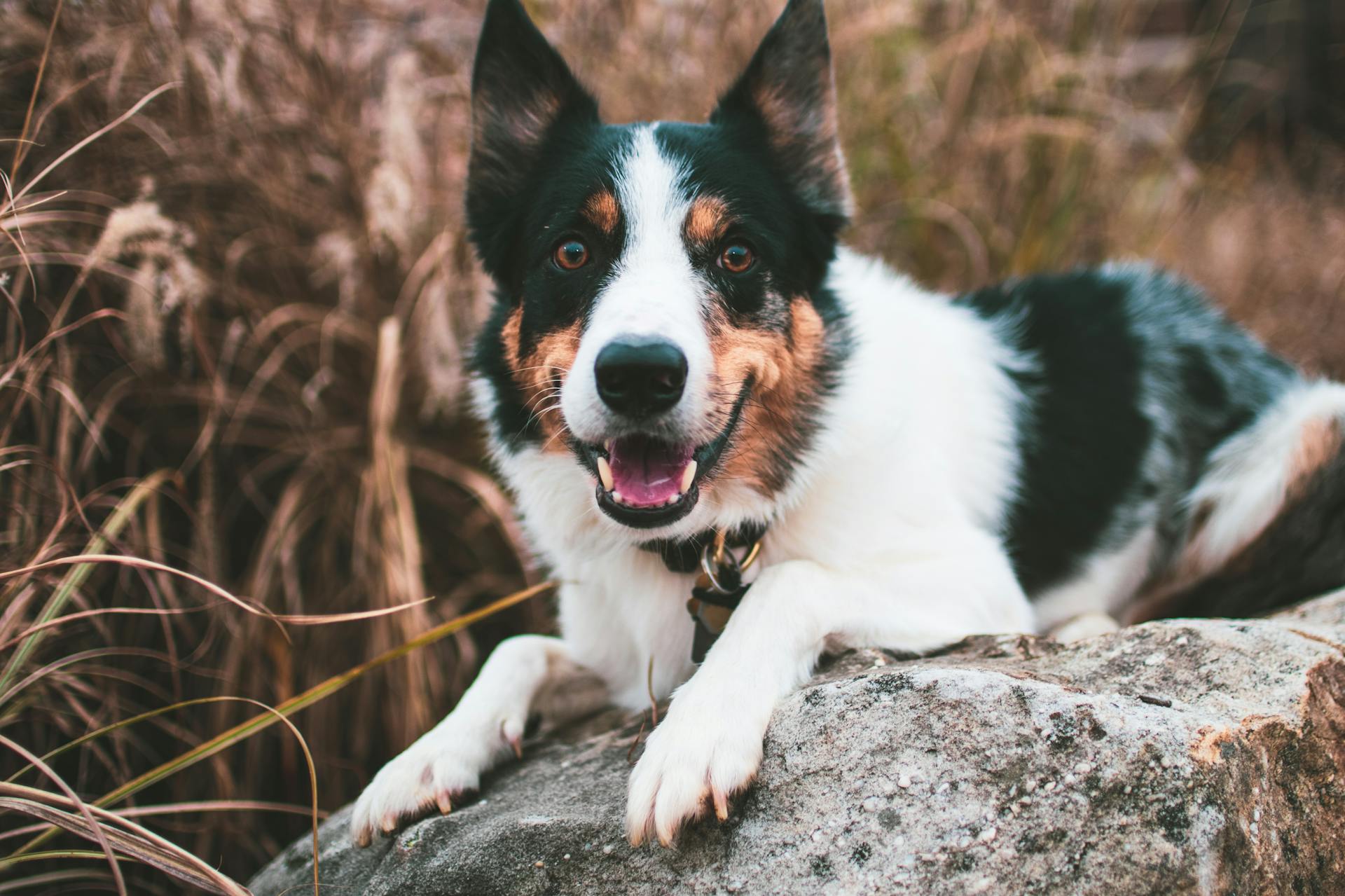
Border Terriers have a unique, wiry coat that requires regular grooming to prevent matting and tangling. This coat type is made up of two layers: a soft undercoat and a harsh outer coat.
To keep your Border Terrier's coat in top condition, you'll need to brush them at least twice a week. Brushing helps to remove loose hair and prevent matting, especially around the ears, legs, and tail.
A slicker brush or a pin brush is ideal for Border Terriers, as they have flexible pins that can gently work through the undercoat without causing breakage. Regular brushing also helps to distribute skin oils, keeping their coat healthy and shiny.
Border Terriers are generally low-maintenance when it comes to bathing, but they do need an occasional bath to keep their coat clean. A bath every 2-3 months should be sufficient, unless your dog gets into something messy.
Additional reading: Do Border Collies Need to Be Groomed
Grooming Basics
The Border Terrier has a wiry, weather-resistant coat with a soft, dense undercoat.
To keep their coat in top condition, it's essential to hand strip or pluck it regularly to maintain its harsh texture.
Their face has a distinctive "otter" shape, which is a characteristic feature of the breed.
Nails should be clipped every 4-8 weeks to prevent overgrowth.
Ears should also be cleaned every 4-8 weeks to keep them clean and healthy.
Intriguing read: 8 Week Old Yorkshire Terrier Puppy
Health and Hygiene
Regular brushing is a must for your Border Terrier's teeth. This is especially important for small dogs and those with special diets, as they're prone to dental problems and sensitive teeth.
Daily brushing is ideal, but brushing your dog's teeth on a weekly basis will still make a big difference in preventing gum disease caused by tartar buildup.
Extreme Odor Eliminator can be a lifesaver between baths, helping to keep your Border Terrier smelling fresh and clean after an outdoor adventure.
Border Terriers are prone to ear infections due to their floppy ears, so it's essential to clean their ears regularly with a veterinary-approved cleaner to prevent infections.
Intriguing read: English Bulldog Teeth
Bathing
Bathing is a crucial part of your dog's regular grooming cycle, helping them avoid many diseases and infections.
The frequency of bathing depends on your dog's lifestyle, but a general rule of thumb is to bathe every three months.
Wire-coated dogs, however, may require more frequent bathing, often within a four-to-six week range.
Before bathing, give your dog a good brushing to remove dead hair and mats.
Place a rubber mat in the tub to provide secure footing and fill the tub with three to four inches of lukewarm water.
Use a spray hose, pitcher, or unbreakable cup to wet your dog, taking caution to avoid getting water in the eyes, ears, and nose.
Massage in pet shampoo, saving the head for last, and immediately rinse thoroughly, starting with the head to prevent soap from dripping into the eyes.
For another approach, see: Bull Terrier Head Shape
Teeth
Brushing your pet's teeth is crucial to prevent dental problems and sensitive teeth, especially in small dogs with tiny teeth and those on special diets.
Daily brushing is ideal, but doing so on a weekly basis can significantly help avoid the need for a veterinarian cleaning, which usually requires sedation.
Cavities are rare in dogs, but gum disease caused by tartar buildup is a common issue that requires regular brushing with toothpaste and a toothbrush specifically formulated for dogs.
Regular brushing can easily combat dental problems and sensitive teeth in dogs.
Skin Care
Skin care is an important aspect of your Border Terrier's overall health. Monitor your dog for any changes in their skin.
Skin infections can be an indicator of underlying health issues, so it's crucial to keep an eye out for redness, scaliness or flakiness, hair loss, or discharge. These symptoms can be signs of Cushing's disease, so talk to your vet if you notice any of these changes.
Recommended read: How to Treat English Bulldog Skin Problems
Ear Care
Ear Care is essential for your furry friend's overall health, especially if they have floppy ears like the Border Terrier. Floppy ears can develop ear infections more easily than dogs with pricked ears.
Regular ear cleaning can help prevent infections. Talk with your veterinarian about how often you should clean your dog's ears with a veterinary-approved cleaner.
Wire coated dogs have sensitive ears covered in hair that need to be checked weekly for infection and cleaned with a cotton ball. Gently wipe a cotton ball moistened with mineral oil, olive oil, or witch hazel in your dog's ear, being careful to avoid the ear canal.
Never use a Q-Tip, which could cause damage to the inner ear if your dog suddenly shakes or jerks his head.
Coat and Paw Care
Border Terriers require regular grooming to maintain their distinctive wiry coat and healthy paws. To keep their coat in top shape, they need to be handstripped twice a year.
For routine upkeep, a slicker brush can be used as needed to keep their fur looking its best. Handstripping is a process where a groomer removes the dog's hair from the roots by hand, allowing a new coat of wiry hair to grow in.
To keep their paws soft and pliable, Paw Balm should be used weekly. This makes the pads less likely to dry and crack. Here are some tips for maintaining your Border Terrier's paws and nails:
Coat Care
Border Terriers require robust exercise and mental stimulation to keep them happy and healthy, but their wiry fur needs special care.
Border Terriers need to be handstripped twice a year to maintain their characteristic hard coat, which can be difficult to find a groomer to do, so many pet parents may choose to learn the grooming method themselves.
For routine upkeep, pet parents just need to brush their dog's fur with a slicker brush as needed to keep it clean and tangle-free.
Border Terriers have a combination of a short, soft undercoat and a longer wiry, dense outer coat, which has a tendency to mat and tangle if it's not brushed regularly, so weekly brushing is a must.
Use a slicker brush to remove tangles and matting, and gently massage a liquid detangler or baby oil into stubborn tangles to keep your dog's coat looking its best.
Clipping or trimming your dog's coat is a good idea to lessen the chances of matting, tangles, and infestation of fleas and other pests, thus reducing the risk of skin infections.
Leave at least a half-inch of fur to protect your dog from the elements, and use a trimmer or scissors to even out areas around the tail, paws, sanitary areas, and chest as needed.
Hand stripping is a process where a groomer removes the dog's hair from the roots by hand, instead of clipping it, which allows a new coat of wiry hair to grow in.
You might like: Hand Stripping Cairn Terrier
Eyes Ears
Regular inspections and cleanings around your dog's eyes and ears are a must to prevent infections. This is especially true for breeds with sensitive areas, such as wire-coated dogs that need to be checked weekly for infection.
For wire-coated dogs, use a cotton ball moistened with mineral oil, olive oil, or witch hazel to gently clean their ears. Be careful not to insert the cotton ball into the ear canal.
Border Terriers, with their floppy ears, are more prone to ear infections and require regular ear cleanings to prevent this. Talk to your veterinarian about how often to clean your dog's ears with a veterinary-approved cleaner.
Tear stains around the eyes are a common issue for small terriers with white coats, such as West Highland Terriers. Clean around their eyes with a cotton ball or soft cloth to prevent this.
Use a small trimmer to trim excess hair around your dog's eyes, ears, and face. This will help prevent hair from growing into the ear canal or causing tear stains.
A unique perspective: Small Yorkshire Terrier
Paws
Paw care is an essential part of your dog's overall health and well-being. Regularly handling your dog's paws can help it get used to having them touched, making it a more pleasant experience for both of you.
By handling your dog's paws daily, you can help it form a positive association with having its paws touched. This can be done by simply holding and stroking its paws, and rewarding calm behavior with praise and treats.
Paw balm should be used weekly to keep paw pads soft and pliable, making them less likely to dry and crack.
To maintain your dog's paws and nails, follow these simple steps:
- Wipe snow and salt from its paws after walks in the winter.
- Clip its nails 1 to 2 times per month.
- Trim about 1 mm (0.039 in) from the curve of a nail.
- Trim the fur between its paw pads at least 1 to 2 times a year.
Grooming Routine
A border terrier's coat is quite unique, with a wiry, weather-resistant outer coat and a soft, dense undercoat. This combination requires regular grooming to maintain its texture and color.
To keep your border terrier's coat in top shape, brush it daily with a slicker brush, working in the direction of growth. This will help remove dead hair and prevent matting. If you do encounter a mat, spray it with conditioner or mat spray and gently work it out with a metal comb.
It's also essential to clean your border terrier's underside regularly, wiping it with a damp cloth as needed to remove dirt and debris. Check their belly, bottom, and genital area daily, and use a damp cloth or wet wipe to clean any soiled areas.
To keep your border terrier's eyes, ears, and whiskers clean, check them daily for buildup and gently remove any dirt or debris with a damp cloth or wet wipe. And don't forget to clean their teeth every day with a small pet toothbrush and toothpaste labeled for dogs.
After a walk in the rain, towel dry and brush your border terrier's coat to prevent matting and keep it looking its best. And, as a general rule, bathe your border terrier only when absolutely necessary, as over-bathing can strip their coat of its natural oils.
Weekly Grooming Schedule
Remember, a border terrier's coat is hypoallergenic and requires weekly grooming to prevent matting and keep it looking its best. Clipping their coat is not recommended, as it can cause the coat to lose its color and texture. Instead, hand-stripping is the preferred method, best carried out by professional groomers.
Frequently Asked Questions
How do you know when a Border Terrier needs stripping?
Check your Border Terrier's coat by spreading it out with your fingers; if you see dull and soft undercoat, it's time for hand stripping to prevent a blown coat
Is it okay to shave a Border Terrier?
No, shaving a Border Terrier is not recommended as it can lead to skin irritation and affect the growth of new hair. Regular grooming is essential to maintain their unique coat
How often should you cut a Border Terrier?
Border Terriers typically require stripping every 6 months to remove dead hair, and cutting them too soon can be ineffective and uncomfortable for the dog. Regular stripping helps maintain their signature scruffy look and prevents matting.
Sources
- https://wahlusa.com/pet-grooming/product-selector/dog/border-terrier
- https://espree.com/BreedProfiler/border-terrier-grooming-bathing-and-care
- https://www.wikihow.com/Groom-a-Border-Terrier
- https://www.petplan.co.uk/pet-information/dog/breed/border-terrier/
- https://www.petmd.com/dog/breeds/border-terrier
Featured Images: pexels.com


